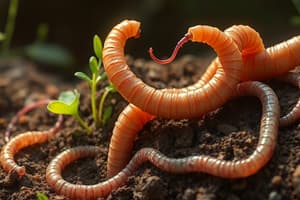Podcast
Questions and Answers
Which ecological category of earthworms is characterized by creating deep, vertical burrows?
Which ecological category of earthworms is characterized by creating deep, vertical burrows?
- Anecic (correct)
- Epi-Endogeic
- Endogeic
- Epigeic
What is the defining characteristic of epigeic earthworms?
What is the defining characteristic of epigeic earthworms?
- Their lack of burrowing activity (correct)
- Their medium size and pale colors
- Their large size and dark coloration
- Their preference for fresh litter and soil
- Their creation of horizontal branching burrows
Which of the following is NOT a function of earthworms in ecosystems?
Which of the following is NOT a function of earthworms in ecosystems?
- Soil pore creation
- Nutrient cycling
- Pollination (correct)
- Decomposition
What is the primary difference between endogeic and epigeic earthworms?
What is the primary difference between endogeic and epigeic earthworms?
Which ecological category of earthworms is most likely to be found in association with a mound of cast material?
Which ecological category of earthworms is most likely to be found in association with a mound of cast material?
Flashcards
Anecic Earthworms
Anecic Earthworms
Large, dark-colored earthworms that dig deep into the soil and feed on fresh litter.
Endogeic Earthworms
Endogeic Earthworms
Medium-sized, pale earthworms that create horizontal burrows and feed on soil.
Epigeic Earthworms
Epigeic Earthworms
Small, brightly colored earthworms that live on the soil surface and do not create burrows.
Ecosystem Functions of Earthworms
Ecosystem Functions of Earthworms
Signup and view all the flashcards
Epi-Endogeic Earthworms
Epi-Endogeic Earthworms
Signup and view all the flashcards
Study Notes
Earthworm Ecological Categories
- Earthworms are categorized ecologically based on their feeding and burrowing behaviors
- Three major groups exist: Anecic, Endogeic, and Epigeic
Anecic Earthworms
- Burrowing Behavior: Dig deep, vertical, unbranching burrows
- Size: Large
- Feeding: Fresh litter feeder, soil dweller
- Color: Pigmented skin
- Casts: Middens (piles of casts) around burrow entrances
- Burrow Depth: Up to two meters
Endogeic Earthworms
- Burrowing Behavior: Create a network of horizontal, branching burrows
- Size: Small to medium-sized
- Feeding: Soil feeder, mineral soil dweller
- Color: No skin pigmentation
- Burrow Location: 0-50 cm in the soil
- Burrow Depth: Usually don't burrow very deeply
Epigeic Earthworms
- Burrowing Behavior: Tend not to burrow, live on the surface in leaf litter, deadwood, dung, compost
- Size: Small
- Feeding: Litter dweller, feeder
- Color: Pigmented skin
- Location: Found on the surface or just below the surface in the leaf litter
Studying That Suits You
Use AI to generate personalized quizzes and flashcards to suit your learning preferences.





